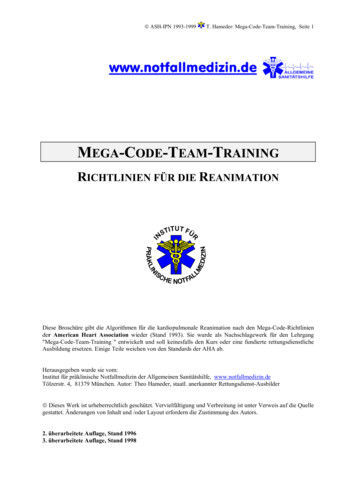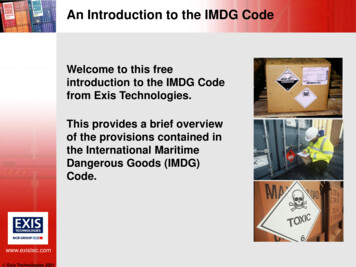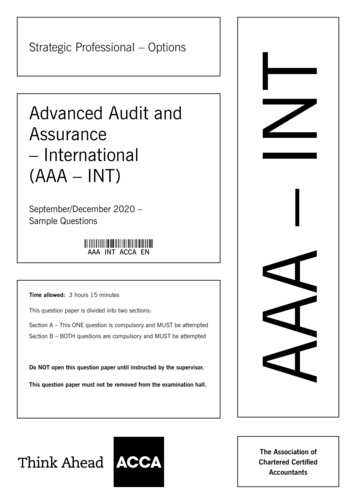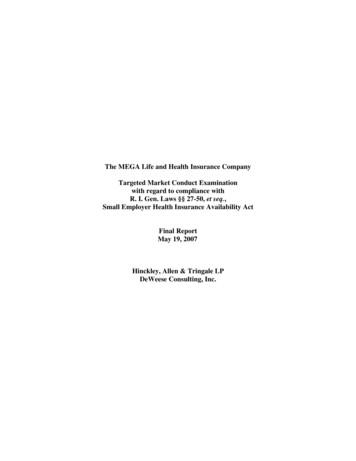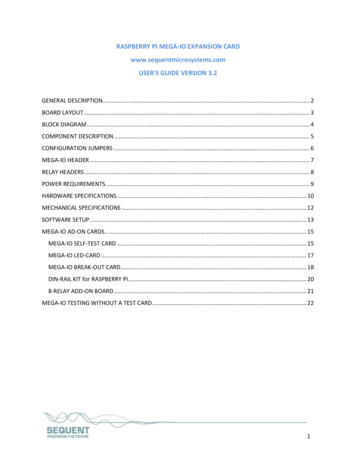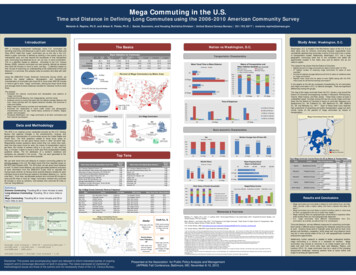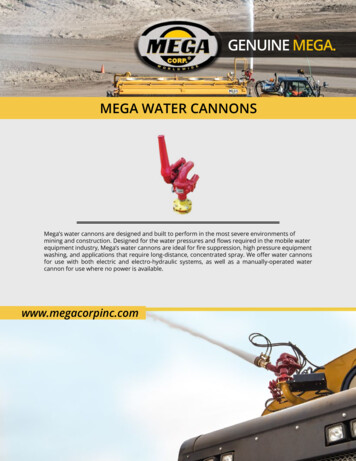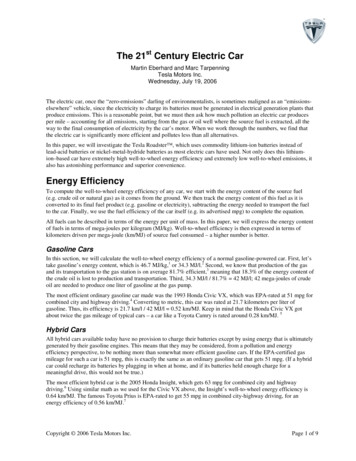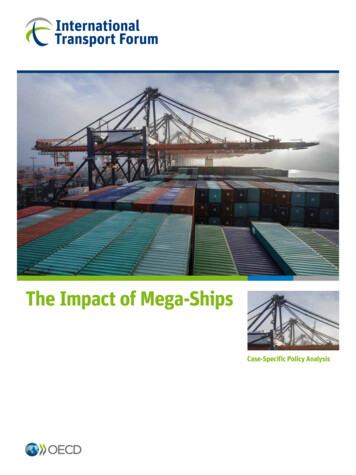
Transcription
The Impact of Mega-ShipsCase-Specific Policy Analysis
The Impact of Mega-ShipsCase-Specific Policy Analysis
INTERNATIONAL TRANSPORT FORUMThe International Transport Forum at the OECD is an intergovernmental organisation with 54member countries. It acts as a strategic think tank with the objective of helping shape the transport policyagenda on a global level and ensuring that it contributes to economic growth, environmental protection,social inclusion and the preservation of human life and well-being. The International Transport Forumorganises an Annual Summit of ministers along with leading representatives from industry, civil societyand academia.The International Transport Forum was created under a Declaration issued by the Council ofMinisters of the ECMT (European Conference of Ministers of Transport) at its Ministerial Session in May2006 under the legal authority of the Protocol of the ECMT, signed in Brussels on 17 October 1953, andlegal instruments of the OECD.The Members of the Forum are: Albania, Armenia, Australia, Austria, Azerbaijan, Belarus, Belgium,Bosnia and Herzegovina, Bulgaria, Canada, Chile, China (People’s Republic of), Croatia, Czech Republic,Denmark, Estonia, Finland, France, Former Yugoslav Republic of Macedonia, Georgia, Germany, Greece,Hungary, Iceland, India, Ireland, Italy, Japan, Korea, Latvia, Liechtenstein, Lithuania, Luxembourg,Malta, Mexico, Republic of Moldova, Montenegro, Netherlands, New Zealand, Norway, Poland, Portugal,Romania, Russian Federation, Serbia, Slovak Republic, Slovenia, Spain, Sweden, Switzerland, Turkey,Ukraine, United Kingdom and United States.The International Transport Forum’s Research Centre gathers statistics and conducts co-operativeresearch programmes addressing all modes of transport. Its findings are widely disseminated and supportpolicy making in Member countries as well as contributing to the Annual Summit.Further information about the International Transport Forum is available s work is published under the responsibility of the Secretary-General of the InternationalTransport Forum. The opinions expressed and arguments employed herein do not necessarily reflect theofficial views of International Transport Forum member countries.This document and any map included herein are without prejudice to the status of or sovereignty over any territory, to thedelimitation of international frontiers and boundaries and to the name of any territory, city or area.
AcknowledgmentsThis report forms part of an OECD/ITF project on the Impact of Mega-Ships, directed by Olaf Merk.This report is written by Olaf Merk, Bénédicte Busquet and Raimonds Aronietis. Written contributionswere provided by Alain Lumbroso (OECD/ITF); as well as Burkhard Lemper, Sönke Maatsch andMichael Tasto from ISL. Visual contributions were provided by Philippe Rekacewicz, Philippe Rivièreand Agnès Stienne. Voluntary contributions that enabled the project were provided by the port ofGothenburg, Hamburg Port Authority and IPC (Indonesia). The report has made use of datasets providedby port terminal operators, ports, Lloyds Intelligence Unit and ISL; as well as OECD/ITF datasets.Valuable comments on a draft version of the report were provided by Stephen Perkins (OECD /ITF),José Viegas (OECD/ITF), Viktor Algurén (Port of Gothenburg) and Ingo Fehrs (Hamburg PortAuthority). The report was formatted by Delphine Malbrancq.The report has made use of insights and data collected during study missions to Hamburg andGothenburg, as well as interviews with a range of relevant stakeholders. A list of the interviewed peopleis included in Annex 7. As part of the project, an expert meeting was organised 10 April 2015 in Paris;participants to this workshop are included in the list of interviewed people.
TABLE OF CONTENTS – 5Table of contentsForeword . 7Executive summary . 9Policy recommendations . 11Chapter 1. mega-ships: trends and rationale . 13Relevance of the subject . 13Definitions and scope of this study . 14The demand for mega-ships . 15Trends in different shipping sectors . 16Heading towards a disequilibrium of costs and benefits of mega-ships? . 19Chapter 2. Mega-ships and maritime transport . 21Costs of container ships . 21Cost savings of mega-container ships . 24The limits to vessel cost savings . 27Sea-side concerns related to mega-ships. 30Chapter 3. Ports and infrastructure adaptations . 33Main trade lanes and ports for mega-ships . 33What are the main barriers to access ports? . 38Other infrastructure fixes . 40Impacts of a next round of larger ships . 42Chapter 4. Mega-ships and peaks . 47Ship to shore peaks . 47Peaks in yard operations . 53Peaks related to hinterland . 55Do mega-peaks require a productivity revolution? . 59Chapter 5. Mega-ships and the transport chain . 63Costs imposed on the whole transport chain. 63Alignment of incentives to public interests . 65Collaboration . 69Regulation of mega-ship development?. 76Governance of the supply chain. 79Annexes . 811. Yard utilisation related to mega-ships2. Calculations economies of scale of mega-ships. 833. Cascading effects following 24,000 teu ships. 924. Patents related to port terminal productivity . 955. Transport costs related to mega-ships . 966. Container ship size and port dues in selected ports . 100THE IMPACT OF MEGA-SHIPS OECD/ITF 2015
6 – TABLE OF CONTENTS7. List of interviewed people . 102References . 104THE IMPACT OF MEGA-SHIPS OECD/ITF 2015
FOREWORD – 7ForewordContainer ships are the work-horses of the globalized economy: although they represent only oneeighth of the total world fleet they are essential for the transport of consumer goods around the world.Container ships have grown bigger at a rapid pace over the last decades, faster than any other ship type.In one decade, the average capacity of a container ship has doubled. The largest container ship at thismoment can carry 19,200 containers1, but ships with capacity of more than 21,000 containers have beenordered and will be operational in 2017.Larger container ships have generated cost savings for carriers, decreased maritime transport costsand as such facilitated global trade in the past. However, larger ships require adaptations ofinfrastructure, equipment and cause larger peaks in container traffic in ports, with wide-ranging impacts.This report assesses if the benefits of the current mega container ships still outweigh their costs to thewhole transport chain.This report is part of the OECD/ITF Mega-Ship project. Other publications that will be releasedwithin the framework of this project include case studies of Hamburg, Gothenburg and Jakarta.1Twenty foot containersTHE IMPACT OF MEGA-SHIPS OECD/ITF 2015
EXECUTIVE SUMMARY – 9Executive summary Cost savings from bigger container ships are decreasingThe transport costs due to larger ships could be substantialSupply chain risks related to mega-container ships are risingPublic policies need to better take account of this and act accordinglyFurther increase of maximum container ship size would raise transport costsThere are cost savings of mega-ships, but these are decreasing and might not even be realized.Doubling the maximum container ship size over the last decade has reduced total vessel costs pertransported container by roughly a third. However, these cost savings are decreasing with size; the costsavings of the newest generation of containerships are four to six times smaller than the savings from theprevious round of upsizing. Approximately 60% of the cost savings of the most recent container ships arerelated to more efficient engines and not to scale. In addition, mega-ship development and the relatedcontainer fleet capacity growth has taken place despite sluggish growth of world containerized seabornetrade. The massive ordering of new mega-ships has resulted in oversupply of container ships, which willmost likely dampen some of the cost savings due to larger ships, as low demand results in fewer savingsper transported container.The transport costs due to larger ships could be substantial. There are size-related fixes toexisting infrastructure, such as bridge height, river width/depth, quay wall strengthening, berthdeepening, canals/locks and port equipment (crane height, outreach). Mega-ships also require expansionof infrastructure to cater to the higher peaks related to mega-ships; as a result, more physical yard andberth capacity is needed. These annualised transport costs related to mega-ships could amount to US 0.4billion, according to our rough and tentative estimations. Roughly a third of the additional costs might berelated to equipment, a third to dredging and another third to port infrastructure and port hinterland costs.A substantial share of the dredging, infrastructure and hinterland connection costs are costs to the publicsector in many countries.Supply chain risks related to bigger container ships are rising. There are concerns aboutinsurability of mega-ships and the costs of potential salvage in case of accidents. Mega-ships also lead toservice and cargo concentration, reduced choice and more limited supply chain resilience, especiallysince bigger ships have coincided with increased cooperation of the main shipping lines in four alliances.In addition,Public policies need to better take account of this and act accordingly. Key question is how thecosts for the public sector imposed by mega-ships could be covered. Many ports and countries have,either accidentally or on purpose, encouraged the development of mega-ships. More balanced decisionmaking would be needed, with clearer alignment of incentives to public interests, policy support toTHE IMPACT OF MEGA-SHIPS OECD/ITF 2015
10 – EXECUTIVE SUMMARYenhance supply chain productivity, more regional collaboration and the creation of an appropriate forumfor a discussion between liner companies and all other relevant transport actors.Further increase of maximum container ship size would raise transport costs. So one couldwonder if such increases would be desirable. The potential cost savings to carriers appear to be fairlymarginal, but infrastructure upsizing costs could be phenomenal. Introduction of one hundred 24,000TEU ships in 2020 would require substantial investments in those places where these ships would be firstintroduced (Far East, North Europe, Mediterranean), but would also - via cascading effects - result inintroduction of 19,000 TEU ships in North America and 14,000 TEU ships in South America and Africa.This would imply additional investment requirements there as well.THE IMPACT OF MEGA-SHIPS OECD/ITF 2015
POLICY RECOMMENDATIONS – 11Policy recommendationsMake more balanced decisions on accommodating mega-shipsCountries and ports frequently make decisions that seem positive on an individual level, but couldbe detrimental at a collective level. Countries and ports need to consider the costs of accommodatingbigger ships in comparison to the overall economic benefits, including port income, savings to localshippers/importers/exporters, and whether such savings will be sufficient to pay for such costs.Align incentives and costs to public interests and recover costs of mega-shipsCorrect any accidental subsidies or misaligned policies that encourage upsizing, or that providepublic resources to container shipping without appropriate recovery of costs. Measures could include: Design port dues in such a way that they do not provide incentives for the largest ships. Inaddition, introduce mechanisms to recover dredging costs on users, for example via fairwaydues and harbour maintenance fees related to ship size.Clarify application of state aid rules to the ports sector and increase financial transparencyof the ports sector, to avoid that the public sector picks up the bill imposed by shippinglines.Link state aid to the shipping sector (such as the tonnage tax2) to commitments of the sectorto contribute to covering costs related to mega-ships (such as additional dredging needs).3. Provide policy support to ports to enhance supply chain productivity and innovationPolicymakers should work with ports and terminal operators to enhance productivity, so as to makebest use of their assets. This could include: Innovation, technical development, workforce training and skills upgrading. Wherepossible, public policies could reform labour practices and procedures to enhance workforceflexibility.Optimise the use of infrastructure capacity, e.g. by truck appointment systems andincentives for port truck moves during night or at weekends.Release peaks at port terminals via dry ports, where space in ports is constrained.Consider upsizing of hinterland transport modes, such as allowing for larger trains, doublestacking and larger trucks.4. Consider collaboration at a regional and cross-port level2A tonnage tax is a favourable tax regime for shipping companies, based on tonnage of the fleet of thecompany, which can be imposed on shipping companies instead of a regular corporate taxTHE IMPACT OF MEGA-SHIPS OECD/ITF 2015
12 – POLICY RECOMMENDATIONSAs container shipping lines increasingly consolidate and cooperate, so could countries, portauthorities and regulators at a strategic planning level. This could help strengthen the collectivebargaining position of the landside supply chain. Regional or cross-port alignment and coordination onpolicy could help ensure proper allocation of resources while protecting the interest of the supply chainusers. Such collaboration could take place with respect to the following areas: Regulation of competition and policy options, which could include whether or how toregulate ship size.More coordination between port authorities on future port development and investment,which could include port mergers in fragmented port systems to increase bargaining power,where this is possible without compromising competition.More port and freight planning at national and supra-national level, to focus investment inport hinterland links on a limited number of ports. In the case of the European Union thiscould mean reducing the number of core ports in the TEN-T network.5. Stimulate an appropriate forum for discussion between liners and transport stakeholdersContainer lines have typically not consulted anyone on new mega-ships, before they ordered these.A constructive discussion would need to take place with the relevant transport stakeholders, includinggovernments, regulators, port authorities and all interested constituents. The objective could be tofacilitate an exchange of views, an understanding of objectives and plans, and ultimately bettercoordination to ensure optimum supply chain configurations, including optimized use of mega-ships.THE IMPACT OF MEGA-SHIPS OECD/ITF 2015
1. MEGA-SHIPS: TRENDS AND RATIONALE – 13Chapter 1. Mega-Ships: Trends and RationaleRelevance of the subjectShips are getting bigger. The last couple of years have seen excited media coverage of mega-shipsand their maiden calls: longer than four soccer fields, made with more steel than numerous Eiffel Toursetc. The season for big ship announcements seemed to have started: almost every two weeks differentshipping lines announce orders for even bigger ships, forming mathematical series that keeps everyoneguessing on the next number, when and by whom.Figure 1.1. How big are mega-ships?Source: Own elaborationsIncreasing size of container ships is not a new phenomenon. The last decades have seen an almostcontinuous increase of container ship size, driven by container shipping lines in search for economies ofscale. This was to a large extent facilitated by the invention of container shipping that made cargoTHE IMPACT OF MEGA-SHIPS OECD/ITF 2015
14 – 1. MEGA-SHIPS: TRENDS AND RATIONALEhandling much more efficient and enabled the increase of ship size. Containerization has undoubtedlycontributed to decreasing maritime transport costs. As such it has facilitated global trade, which has hadlarge benefits to many people. However, one can wonder if ever larger containerships still have a positivecontribution to society. That is the question that this study aims to answer: what is the impact of megaships?Ship size development might be a different issue than in the past. One of the reasons is the completedisconnect of ship size development from developments in the actual economy. The shipping industry istraditionally a cyclical economic sector, with investments in new ships generally overshooting, creatingamplified periods of overcapacity and under-capacity – which is reflected in fluctuating freight rates. Thedevelopments over the last years seem different. The orders for the new generation of containershipshave been placed in an economic climate that is generally depressed and at best stagnating. Whereasbigger ships since the 1990s could accommodate high sustained levels of external growth, due to the riseof Asian economies, the trade growth to absorb ship developments is currently absent. Shipping lines arebuilding up overcapacity that will most likely be fatal to at least some of them.Another difference is the quicker pace of up-scaling of ship size. As will be shown in this study,ship size increases have accelerated over the last decade. This increasing pace at which new generationsof container ships are conceived and constructed has consequences for the rest of the transport chain:investments in infrastructure and port superstructure are in many cases not yet amortized, whichincreases capital costs and reduces profit margins for port operators and public authorities.Moreover, mega-ships create very large peaks in ports and for hinterland transport. Thisphenomenon is not new, but the scale is unprecedented. It is fair to say that most ports face challengesdealing with these peaks, especially if these occur unexpectedly, e.g. because of lack of reliability byshipping lines. This pain in the supply chain might have reached such heights, that one could wonder if atipping point has not been reached where further ship size increases result in disproportionally higherport and port hinterlands costs?In short, ship size has become one of the most burning issues in maritime transport, withrepercussions for the whole transport chain. Although widely debated in specialized press and journals,there is currently no comprehensive overview of impacts and possible ways to deal with these; this studyaims to fill this gap.Definitions and scope of this studyThis study focuses on container ships. There are various reasons for this focus. Containerships haveseen spectacular increases in size, more than most other ship types, as will be illustrated in section 1.4.Container ships represent around a quarter of the total ship population, a share that has increased over thelast decades as more goods, including commodities traditionally transported in general cargo ships,reefers or bulk carriers, have become containerized. Moreover, container ships are more than some othership types linked to hinterland transport, so have more repercussions along the whole transport chain, e.g.more than liquid bulk tankers often connected to pipelines and bulk carriers with cargo directly deliveredto industries in port areas.There are different ways to measure mega-ships. A common measure is the maximum number oftwenty foot containers that the ship is able to carry: the maximum TEU capacity. Underlying this TEUcapacity are ship characteristics and dimensions that enable this capacity. Container ships are oftenqualified in different “generations” according to their dimensions. The newest generation ofcontainerships, starting with the Triple E-ships of Maersk, in operation since 2013, has an overall lengthof 400 metres, a width (beam) of 59 metres and draft of 16 metres. These ships have container rows withTHE IMPACT OF MEGA-SHIPS OECD/ITF 2015
1. MEGA-SHIPS: TRENDS AND RATIONALE – 1523 containers stacked next to each other. These specifications are important as they determine thecharacteristics of the port and port equipment needed for handling these ships efficiently. As will beillustrated later, many ports have to make adjustments as ships get longer, wider, higher and deeper.Another measure to some extent related to ship size is gross tonnage (GT), which indicates a ship'soverall internal volume. Other somehow related measures are dead weight tonnage (dwt), whichindicates the maximum weight that a ship can carry, a measure more frequently used for bulk carriers andtankers than for container ships.3What is considered a mega-ship depends on time and place. There is a considerable academicliterature on mega-ship, but the dimensions discussed in the 1990s and even the 2000s are not of thesame order. What is a mega-ship also depends on the maritime trade route for which the ship is used. Thelargest container ships are used on the trade lane between the Far East and North Europe, as will beillustrated below. The maximum and average ship size of other trade lanes is lower, but these ships canalso be very large and also present challenges to these ports. As ship size increases, a cascading effecttakes place: ships that have become redundant because of the very large newbuilds are deployed on othertrade lanes, with subsequent trickle-down-effects up to the trade lane with the smallest ship size. So, thedevelopment of ever larger ships not only impacts the trade lanes in which the largest ships are used, butthe whole maritime transport chain.The demand for mega-shipsThe development of ever larger ships is driven by the search of economies of scale by shippingcompanies. Considering that the container shipping industry is mainly driven by price competition – andnot very differentiated with respect to other aspects – the decision by one shipping line to increase shipsize leads to a wave of similar decisions by competing shipping lines in order not to “stay behind” by notreaping the same economies of scale. The result is a wave of investments in new very largecontainerships that might make sense from the perspective of an individual company vis-à-vis its maincompetitors, but less so for an industry as whole, as it results in growth of fleet capacity that is not in linewith demand.Most other actors in the transport chain are not necessarily favourable to mega-ships. Shippers areinterested in frequent and reliable maritime transport links, but bigger ships would reduce the servicefrequency, unless cargo streams growth at the same pace of ship size development; moreover, largeshippers might have a preference to hedge risks by parceling out deliveries in different ships rather thanconcentrating everything in one ship. Terminal operators are confronted with the need to adjustequipment and to handle peaks that are challenging within current configurations. Similar story for portsconfronted with new requirements on port-related infrastructure and transport ministries with regards toport hinterland infrastructure and connectivity. Freight forwarders and logistics operators will beconcerned with any disruptions or delays of mega-ships that might cause additional transaction andcoordination costs. Finally, the peaks associated with mega-ships could cause congestion and delays fortruckers, barge and railway companies. A more detailed analysis of the impact of mega-ships on thesedifferent elements of the transport chains is provided throughout this study.Shipping lines generally do not consult with the other actors in the transport chain on their projects.We have not found any evidence of attempts of coordination or prior warnings in this respect. Evencontainer terminals operating within conglomerates with shipping lines have at some occasions been3There are for example differences in the way in which shipping lines calculate TEU capacity. E.g.Maersk Line quotes the maximum load capacity of their ships in terms of filled TEUs with a 14 tonneload, which will always result in a smaller TEU capacity than the true TEU capacity.THE IMPACT OF MEGA-SHIPS OECD/ITF 2015
16 – 1. MEGA-SHIPS: TRENDS AND RATIONALEsurprised by the ship orders of their mother company – which required them to do retrofits of terminalequipment that was just acquired. One could say that shipping lines have imposed their standards on thewider transport chains, ordering ships with dimensions that other transport actors now have to deal withit. There has been no planned transition. Considering the character of ship size development (in leaps,rather than gradually), what is needed in the related transport chain is a revolution rather than anevolution.Trends in different shipping sectorsContainer ships are the largest ships in the world, at least with regards to length. The overall length(LOA) of the largest container ship is 400 metres, this is longer than the maximum length of currenttankers (380 m), bulk carriers (362 m) or cruise ships (360 m). However, container ships have smallerdrafts than tankers and bulk carriers, which consequently have higher ship volumes (GT) and weightcarrying capacity (dwt). Some of the oil tankers of the past were longer than current container ships(LOA of 458 m), but these oil tankers are no longer in use and have been demolished or found alternativeuses.Table 1.1. Dimensions of largest ships in different ship typesShip typeNameLOABeamDWTGTDraftSinceContainerMSC Oscar39459197,362193,000162015ContainerCSCL Globe40059184,320187,541162014Oil tankerTI class38068441,893234,00624.52002Bulk carrierValemax36265400,000200,000232011Cruise shipOasis class36060.515,000225,2829.32009Source: Own data collectionThe size of container ships has been growing at a faster pace than all other ship types. The averagecontainer ship size up (in dead weight tonnes) over 1996-2015 was 90%, this was 55% for bulk carriersand 21% for tankers (Figure 1.2). Other ship types, such as Ro/Ro-ships and passenger and cruise shipsalso grew at much more moderate growth rates, whereas the average size of general c
Cost savings from bigger container ships are decreasing The transport costs due to larger ships could be substantial Supply chain risks related to mega-container ships are rising Public policies need to better take account of this and act accordingly Further increase of maximum container ship size would raise transport costs


